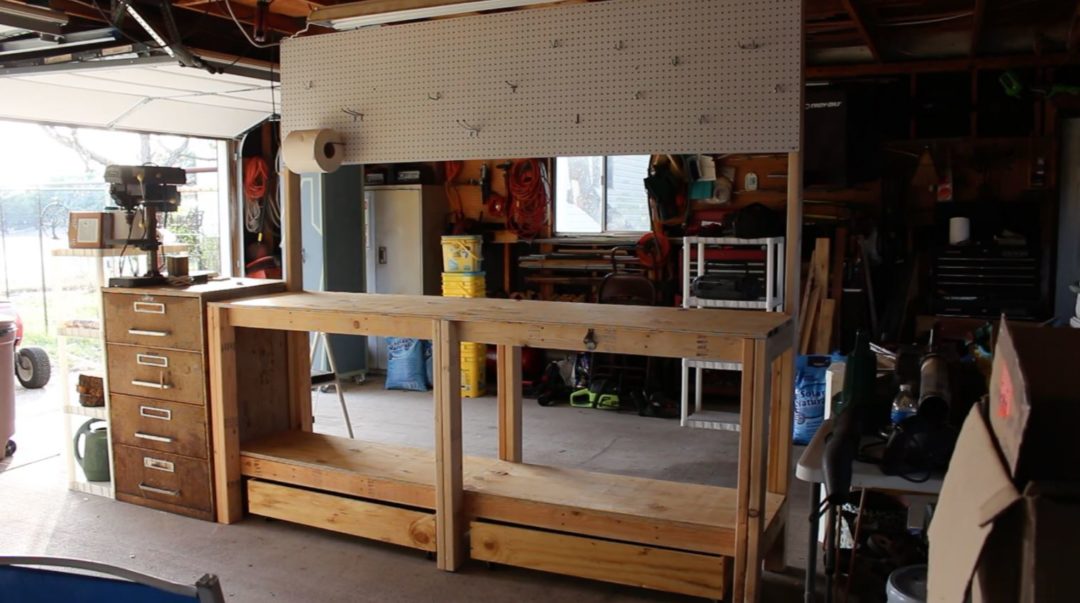
How To Build A Simple 2×4 Workbench
- Workshop DIY Projects
- April Wilkerson
- Updated: March 7, 2023
Thinking about using 2×4 wood to build a simple 2×4 workbench? Check out this easy DIY project where I built a workbench using mostly 2×4’s!
This week I am going to be building a simple workshop workbench that is made up of 2x4s and plywood. It’s a very simple build that any beginner should be able to tackle. This workbench was built for my dad, he just retired and moved to the county and needed a good workbench for his new garage. He told me what he wanted and this is what we came up with. : ) Needless to say, it was a cool change in pace having my dad to hang out with while working.
Now, I have build your own easy workbench plans available if you’re interested in building your own. The plans are 13 pages and come with a cut list, material list, and all the dimensions I used.
The first thing I did was go to the store and purchase all the material I’ll need for the project. While at the big box store, the employees will cut down a sheet of plywood for you for free, so I went ahead and cut my plywood to size to make hauling it around easier.
Now I started working on cutting all of the 2x4s. The easiest tool to use for this would be a miter saw with a stop block, but since I am not in my own shop this week and my Dad does not have a miter saw, I used a circular saw. I would set my 2×4 in my Triton SuperJaws, make my mark, and then use my circular saw to cut it to length.

For most of this build I will be using just glue and a butt joint; however, there are a few joints that I decided to use pocket holes on to prevent having to use extra long screws, so I went ahead and grabbed these four pieces and drilled in my pocket holes.
I grabbed the pieces that make up the ends and joined them all together. Just a side note: these SuperJaws are very handy.

For the legs, instead of using 4x4s (because they’re more expensive), I decided to use two identical lengths of 2x4s glued and screwed together. This will create a leg that is 3 1/2″ by 3″ which will give it a much sturdier footing than just a single 2×4. However, to get away from using extra long screws to go through two 2x4s, I put the bench together in sections, then I combined sections together.
Next, I started assembling the front and back sections of the workbench. I am using glue on all of these joints and the butt joint. Note: I am connecting these horizontal 2x4s so that they are flush with the back of the vertical 2x4s so that whenever the workbench is complete I will have a 1 3/4″ of overhang on the workbench top. You can use this area for clamps.


Once I had two sections built, I went ahead and glued and screwed them together.

I repeated the steps to make a second assembly and this will become the front and back of the workbench.
Once that has been built, I attached the side assemblies, that I created a few steps back, also using glue and screws. Tip: I am pilot drilling these holes just to make screwing down easier. Also, I’m using an impact for the same reason.

Now I went on to attach the bottom shelf. I did this by first attaching the two long joints of 2x4s.

Then I moved back up to the top work surface and added in a few cross braces to add support. I would first use my tape measure to measure over on both the front and back 2x4s and make a mark with a pencil. Then position the 2×4 in place and attach it with glue and screws. Once the top cross braces are in, repeat the steps for the bottom shelf.

Next was to start adding the plywood for the top and bottom. I had the big box store employee cut the plywood to width for me but I needed to cut the corners out or they will go around the end post. To do this easily, grab a scrap 2×4 and set it in the corner then used a pencil to trace around it. I used a jigsaw to cut them out.

I set the plywood bench top in place, then went around the perimeter with screws to attach it. Note: I did not use glue here in case my dad ever wants to replace the top. Also, another option, if you want a thicker workbench top, is to add two pieces of plywood right on top of one another.

I repeated the steps by putting on the bottom self and attaching it using screws.
Making the rolling storage bins.
I decided to make two large storage bins that will tuck under the workbench, just to utilize some wasted space…these are essentially a drawer on wheels.
I first cut all of my pieces to make up the two drawers. Next, I made a 1/2″ dado near the bottom on the side and front pieces. Then cut a bottom and started putting the bin together. I used glue and screws for all of these joints. Once I had the sides together with the front and back, I simply slipped in the bottom and had a drawer.


To make it mobile, I flipped the drawer over and added four 1 1/2″ casters to each bin. Because I didn’t have short enough screws to only go into 1/2″ material, I cut some scrap from 3/4″ material and attached those underneath each caster just to give the screw more meat to screw into.



Now I added the pegboard. My dad wanted a space so that he could reach the workbench from either side so the pegboard on his does not go all the way down; however, an alternative design would be for the pegboard to go all the way down the workbench.
The pegboard is flimsy so to give it some support, I first ran two lengths of 2x4s between the end posts and attached them with glue and screws. To add the pegboard, I used screws to attach it to the end post.

That’s it! I think my dad is going to be able to get a lot of use out of this and of course it was a lot of fun being able to work with him. My dad was an aircraft mechanic his entire career so this was his first time involved in a wood working project. He still has a ways to go on getting his garage organized, but having a workbench will certainly help him get going.

If you liked this project and want to stay up to date with what I’m building, then be sure to sign up for my email newsletter and you’ll get an email when I post something new. See you soon!
*Disclosure: Some links in this post are affiliate links meaning, I may get a commission if you make a purchase. Thanks for your support in this way!